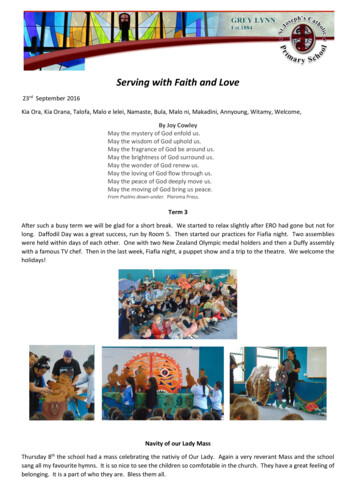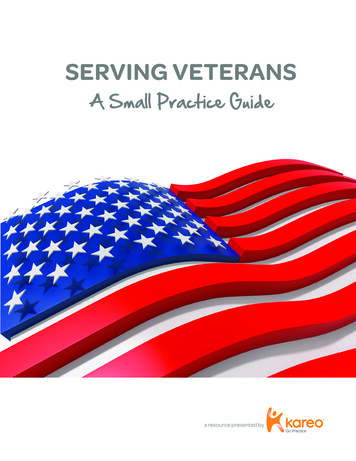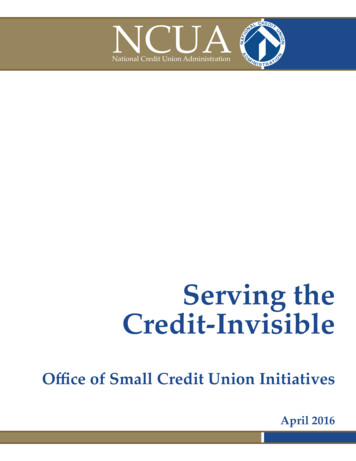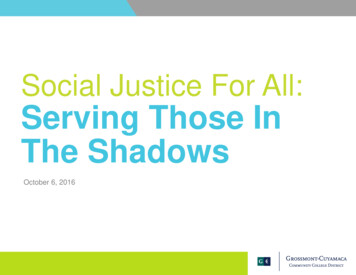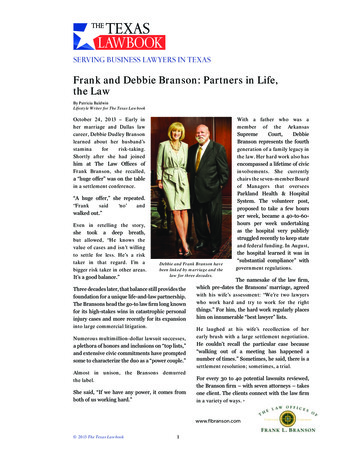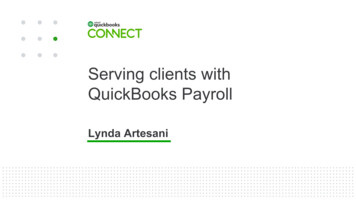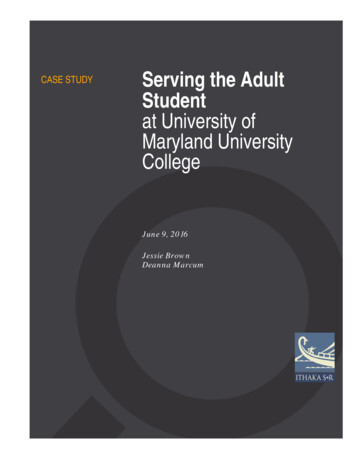
Transcription
CASE STUDYServing the AdultStudentat University ofMaryland UniversityCollegeJune 9, 2016Jessie BrownDeanna Marcum
Ithaka S R is a strategic consultingand research service provided byITHAKA, a not-for-profitorganization dedicated to helping theacademic community use digitaltechnologies to preserve the scholarlyrecord and to advance research andteaching in sustainable ways. IthakaS R focuses on the transformation ofscholarship and teaching in an onlineenvironment, with the goal ofidentifying the critical issues facingour community and acting as acatalyst for change. JSTOR, aresearch and learning platform, andPortico, a digital preservationservice, are also part of ITHAKA.SERVING THE ADULT STUDENT AT UNIVERSITY OF MARYLAND UNIVERSITY COLLEGECopyright 2016 ITHAKA. This work islicensed under a Creative CommonsAttribution-NonCommercial 4.0International License. To view a copy ofthe license, please see AKA is interested in disseminatingthis brief as widely as possible. Pleasecontact us with any questions about usingthe report: research@ithaka.org.1
IntroductionConventional conceptualizations of the “typical” college student as an eighteen-year old,full-time, residential student poorly match reality. Roughly 70 percent of today’s collegestudents are “nontraditional students,” meaning that they are over the age of 24,commute to campus, work part or full-time, are financially independent, or havechildren. Some enter college with only a GED, while others are reentry students with anassemblage of credits from various institutions. Many of these students are low-income,the first in their families to attend college, or come from underrepresented racial andethnic groups. 1The educational delivery formats and financial aid policiesof many four-year colleges and universities are not welldesigned to support these nontraditional students.The educational delivery formats and financial aid policies of many four-year collegesand universities are not well-designed to support these nontraditional students. Mostinstitutions require that students rearrange their schedules and sideline competing lifedemands so that they can participate in a system designed for students who haverecently completed high school. This can be an unreasonable demand for students whomust work full-time, commute long distances, or have families to support, and leadsmany to withdraw from post-secondary institutions all together.This case study looks at The University of Maryland University College (UMUC), aninstitution that was planned—from inception—to serve geographically dispersed adultlearners and makes supporting these types of student central to all of its operations. Thisreport traces UMUC’s development from a division within University of Maryland,College Park, designed to serve veterans and military students, to its establishment as anindependent, non-profit, public institution within the University System of Maryland(USM). In particular, we focus on recent curricular and operational changes at UMUCand illustrate how, in recent years, UMUC has enhanced its mission to equip adult1See Jessie Brown, “Shifting Policy to Support the ‘Typical’ College Student,” Ithaka S R Blog (August 14, y-to-support-the-typical-college-student/; Jenna Johnson, “Today’s TypicalCollege Students Often Juggle Work, Children and Bills with coursework,” The Washington Post (September 14, 58c8c0-1718-11e3-804b-d3a1a3a18f2c story.htmlSERVING THE ADULT STUDENT AT UNIVERSITY OF MARYLAND UNIVERSITY COLLEGE2
learners with twenty first-century skills through effective leadership, the diligent use ofdata, and a culture of collaboration.Currently, UMUC serves nearly 85,000 students (nearly 70,000 undergraduates). It isheadquartered in Adelphi, Maryland, and offers classes and services at several locationsthroughout the state and the country. UMUC also offers face-to-face courses at militarybases in Europe, Asia, Africa, and the Middle East, but most students take their coursesonline. 2 The university is notable among public four-year institutions for its strong focuson online course delivery, the emphasis it places on workforce development, its facultymodel, and its use of data for student support, program design, and institutional decisionmaking. The institution uses each of these approaches to deliver on its mission tosupport adult students.To get a better sense of how its singular focus on serving the needs of nontraditional,adult students structures its operations, we spent two days at UMUC in February 2016interviewing administrators, staff, and faculty. In addition, we spoke via phone withstudents who were enrolled in UMUC’s online courses. In our interviews, we focused onUMUC’s approach to adult learning, paying special attention to recent changes andinitiatives, many of which are still in progress.While UMUC’s history of serving adult students makes it distinctive, the strategies it haspursued to support this population provide valuable lessons to a variety of institutionsthat enroll growing shares of nontraditional learners. In addition, UMUC’sorganizational culture and successful approach to change management have allowed theinstitution to be remarkably effective in advancing substantial, mission-alignedinnovations over the past several years. While some of the factors that have allowedUMUC to successfully transform are unique to the institution, others are more broadlyapplicable, and offer rich examples of strategic change management in higher education.Origins and OperationsFrom its creation, UMUC has been at the forefront of adult education and distanceeducation, especially for military students. The institution began as a unit withinUniversity of Maryland College Park’s College of Education, called the College of Specialand Continuation Studies (CSCS). Established in 1947, the unit was designed toaccommodate the increasing enrollment of veterans after World War II and the passage2In 2015, 86 percent of all enrolled students took at least one course online. See UMUC’s Fiscal Year 2015 Fact Book,Prepared by the Office of Institutional Research (2015), c-fact-bookfy15.pdf.SERVING THE ADULT STUDENT AT UNIVERSITY OF MARYLAND UNIVERSITY COLLEGE3
of the GI Bill. CSCS was re-named University College in 1959, offering educationaloptions to civilians and their families in Maryland, Asia, Europe, the North Atlantic,Africa and the Middle East. In 1970, it became a separately incorporated and accreditedinstitution—University of Maryland University College—within the University System ofMaryland. Throughout the course of these developments, the institution maintained itsfocus on serving adult and military students. 3Today, UMUC continues to operate physical locations on military bases in more than 20countries in Asia and Europe. However, since the 1990s, due to the combination of ashrinking military and increasing interest in and capacity for online education, UMUCbegan to focus more on stateside operations and digital education, while maintaining itsfocus on educating adult, nontraditional, and military students. In fiscal year 2015,UMUC enrolled almost 52,000 active duty military, reservist, dependent, or veteranstudents. Approximately 75 percent of stateside enrollees worked full-time, 54 percentwere working parents, and the median age for stateside undergraduates was 31. 4Despite some of the apparent and real similarities betweenUMUC’s educational model and those of for-profitinstitutions, UMUC’s fees are substantially less than thosecharged at most for-profit institutions, and its investmentstrategy focuses on providing value to students, rather thanprofit for the institution.Despite this distinct focus, UMUC remains one of the 12 non-profit, public institutionswithin the University of Maryland system, and 32,000 of the nearly 85,000 students itserves reside within the state of Maryland (though most take courses online). UMUCreceives fewer allocations from the state than any other institution within the system, butstill retains a public mission to offer its students a quality, affordable education(currently, it has the second lowest tuition of all USM schools). Therefore, despite someof the apparent and real similarities between UMUC’s educational model and those offor-profit institutions, UMUC’s fees are substantially less than those charged at most for-3For UMUC’s history, see “Strategic Plan 2015-2018,” University of Maryland University College (2015),https://issuu.com/umucachiever/docs/umuc strategic plan?e 5712148/12994035.4“UMUC at a Glance,” UMUC Office of Institutional Research,” http://www.umuc.edu/visitors/about/ipra/.SERVING THE ADULT STUDENT AT UNIVERSITY OF MARYLAND UNIVERSITY COLLEGE4
profit institutions, and its investment strategy focuses on providing value to students,rather than profit for the institution. In addition, because of its long-standingcommitment to serving adult and nontraditional students, UMUC sits at the forefront ofsystem efforts to instill a culture of innovation and promote workforce development.USM leaders hold up UMUC’s innovative initiatives as examples of what moretraditional institutions in the system should aspire to achieve.The Student ExperienceWhen asked to describe UMUC’s approach to education, Marie Cini, provost and seniorvice president of academic affairs, explains that every decision at UMUC is informed byserving the adult student. “When you focus on the student,” explains Cini, “everythingelse comes naturally.” Our interviews with other UMUC staff, faculty, andadministrators, as well as the additional research we have done on the institution,corroborate the primacy of the learner.The flexibility of online courses works especially well forstudents with family, professional or other life obligations,and can be effective at increasing access for nontraditionalstudents while removing logistical barriers to completion.One of the most apparent—and increasingly mainstream—ways in which UMUC’sapproach accommodates the adult learner is through online course delivery. UMUC wasan early pioneer in online education and has been offering online courses since 1993(before this, UMUC offered correspondence distance options to overseas students).Today, UMUC online course delivery constitutes a substantial share of the institution’soperations: in fall 2015, UMUC offered 927 unique online courses (4,736 sections) and87 percent of all enrolled students took at least one online course. 5 As leaders and facultyat many other institutions are coming to realize, the flexibility of online courses worksespecially well for students with family, professional or other life obligations, and can beeffective at increasing access for nontraditional students while removing logisticalbarriers to completion.5“UMUC Fall 2015 Factbook,” UMUC Office of Institutional Research (Fall ad/umuc-factbook-fall-2015.pdf.SERVING THE ADULT STUDENT AT UNIVERSITY OF MARYLAND UNIVERSITY COLLEGE5
UMUC’s approach to online education is noteworthy not only for its scale and history,but also for the thought and effort invested in creating remote communities of studentsand faculty. Students with whom we spoke reported that online discussions and forumswere often more engaging and participatory than face-to-face courses they hadencountered in earlier educational experiences. Faculty have regular remote meetings, aswell as ad-hoc video and conference calls to troubleshoot larger curricular issues, andprogram chairs are intentional about creating faculty communities of practice. Facultymembers also use a social media platform that creates communities by class throughwhich they share resources and discuss strategies for a given course.Nearly all of UMUC’s courses are taught by adjunct faculty members who work part-timeand are hired on a contract basis. All adjunct faculty are what UMUC calls “scholarpractitioners,” meaning that they have advanced degrees and actively work in the field inwhich they teach. Institutional leaders explain that this model, which has been in placesince the institution was established, stems directly from UMUC’s focus on the adultlearner: giving students the opportunity to learn from professionals in their field addsrichness to UMUC’s curricular focus on workforce development. Faculty are hired asprofessional teachers, not as discipline-based research faculty, thereby strengthening thestudent-centric approach.While UMUC’s heavy reliance on adjuncts may raise eyebrows among traditional tenuretrack faculty, especially with the increasing use of contingent faculty at traditionalinstitutions of higher education, it is an intentional part of UMUC’s pedagogical andeducational model, rather than an explicit cost-saving strategy at odds with educationalquality. Students with whom we spoke reported that they enjoyed learning from peoplein their intended (or current) professional field, and faculty explained that their studentsbenefitted from hearing about their practical experience and insights. Institutionalleaders are clear about their expectations for faculty to teach, and are decisive in theirunderstanding that the role is for professionals interested in giving back, rather than forscholars invested in disciplinary research. The institution’s hiring practices andrecruitment communications are explicit about this.UMUC’s student-centric, workforce-oriented faculty model has also allowed theinstitution to make broad sweeping changes more quickly than more traditionallystructured schools can, while allowing it to scale educational operations to 84,000students. Like many of UMUC’s other operations, this approach grows out of theinstitution’s focus on what works best for adult learners, and has allowed the institutionto provide broader access and more appropriate educational experiences for theselearners.SERVING THE ADULT STUDENT AT UNIVERSITY OF MARYLAND UNIVERSITY COLLEGE6
In addition to offering online courses taught by scholar-practitioners, over the pastseveral years, UMUC has built up a strong, centralized support system for onlinestudents. Particularly notable is what UMUC calls its first-tier support system, which is a24-hour call center from which students can seek advice on issues related to registration,financial aid, technical issues, and campus resources. If a student needs additionalsupport, he or she is referred to an advisor or staff member with more specialization.This system, which borrows many of its approaches from the corporate customer serviceworld, works well for digitally engaged and globally dispersed students, and ensures thatbusy students can easily resolve financial aid, registration, technical, or similar issueswith a single telephone call at whatever time they need assistance.Recent Changes in Leadership and CultureThese recent changes in UMUC’s student support strategy are indicative of a larger shiftat UMUC. While UMUC has always focused on serving adult learners, it has done soespecially effectively through a series of recent functional changes and curricularinnovations. These transformations were catalyzed by turnover in senior leadership, andaccelerated by mounting pressure to increase enrollments, manage resources, improvestudent outcomes, and better bridge the career skill gap. Strong leadership successfullyimplemented a process of change based on an institutional investment in data andanalytics, and an intentionally collaborative approach to planning and design.There is a broad consensus across campus that the initiatives and strategies that wediscuss in this section would not be possible without the leadership of President JavierMiyares and Provost Marie Cini. Miyares, previously the senior vice president forinstitutional effectiveness, stepped in as interim president in 2012, and, afterdemonstrated success, continued in the role. By his own admission, Miyares neverimagined himself as a university president. Rather, he considered himself the “data-guy,”and many of the changes under his leadership have been informed, designed, and refinedunder the guidance of the newly created UMUC Office of Analytics. 6Spearheaded by Miyares, the office of analytics employs a highly-skilled team of analystswho not only have backgrounds in data analysis, but also have experience in variousfunctional areas of the institution. Analysts work as embedded team members orconsultants within the functional areas in which they have expertise, helping these teamsbetter understand their data and make decisions informed by their analyses. Thiscollaborative analytical approach has been used to improve processes and outcomes in a6See Meris Stansbury, “College president reimagines analytics with dramatic success,” eCampus News (November 2,2015), ytics-265/SERVING THE ADULT STUDENT AT UNIVERSITY OF MARYLAND UNIVERSITY COLLEGE7
variety of areas, from enrollment management, to marketing, to finance, to studentretention and success. Faculty and staff speak favorably about the marked shift ininstitutional culture that it has affected. 7Shortly after stepping into the role of president, Miyares appointed Marie Cini as interimprovost in June 2012, and then permanently as provost and senior vice president ofacademic affairs in 2013. Previously, Cini was the vice president and dean for UMUC’sundergraduate school. She held similar roles in other institutions before coming toUMUC, but her entire career had been focused on working with adult students. With thisbackground, Cini entered the role of provost with an orientation towards innovation andrisk-taking. She speaks with conviction about the importance of nontraditional thinkingand nontraditional approaches at UMUC.Crucial to UMUC’s successful process of changemanagement has been a strong, distributed leadershipteam that is open to new ways of working andcollaboration.Cini’s innovative vision has been behind many of UMUC’s recent curricular innovations(discussed below), while Miyares’ commitment to collaborative, data-driven decisionmaking has provided a useful methodology through which these innovations have beendesigned and implemented. Also crucial to UMUC’s successful process of changemanagement has been a strong, distributed leadership team that is open to new ways ofworking and collaboration. In particular, Cini and Miyares have been strategic aboutassembling a staff of leaders with a diverse range of backgrounds in corporate settings,for profit-institutions, public non-profit education. Leaders with corporate backgroundshave implemented systems and approaches that are useful for efficiently managing somany dispersed students at a large scale (such as high-capacity, centralized businesssystems and the 24-hour student call-in center). Part of the motivation for hiring leadersfrom corporate and for-profit educational institutions is to ensure that UMUC can keeppace with other adult-serving institutions while remaining true to its public mission.7In 2015, UMUC spun its office of analytics off as a profit-making venture called Heliocampus. UMUC will use its dataanalytics capacity, as well as its unique consulting model, to help other institutions make better use of their data. See theHeliocampus website, http://www.heliocampus.com/. See also Sarah Gantz, “UMUC turned its Office of Analytics into asoftware startup,” Baltimore Business Journal (September 22, tics-into-a.html.SERVING THE ADULT STUDENT AT UNIVERSITY OF MARYLAND UNIVERSITY COLLEGE8
Transforming the Academic ModelThe UMUC leadership team has
institution—University of Maryland University College—within the University System of Maryland. Throughout the course of these developments, the institution maintained its focus on serving adult and military students. 3. Today, UMUC continues to operate physical locations on mil

